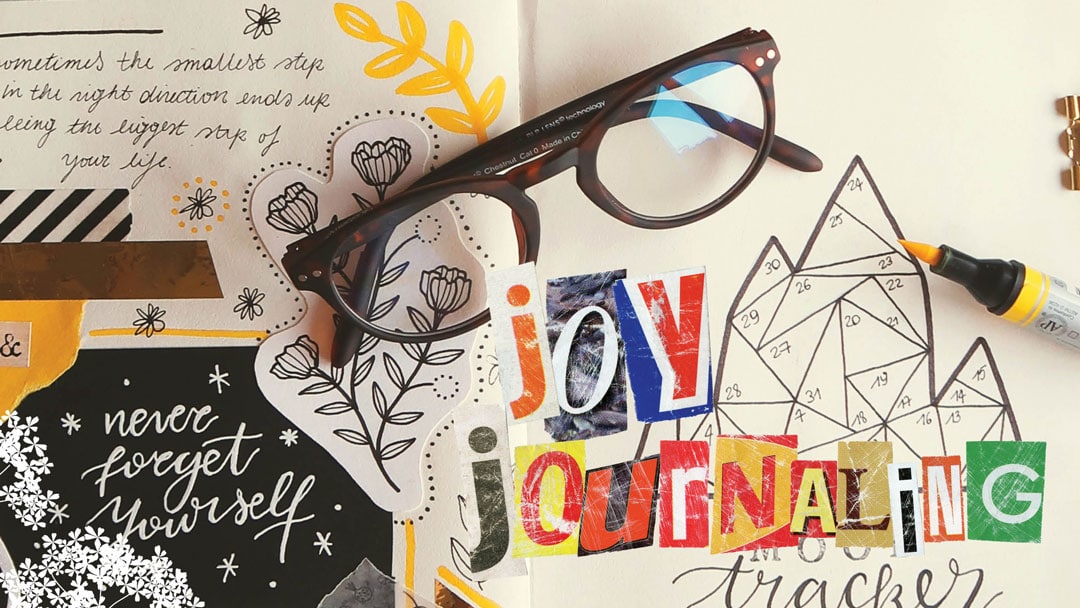Joy journaling might become your new favorite thing to do with your tween or teen. When I want my fifteen-year-old to hang out with me, all I have to do is spread my supplies out on the kitchen table and enjoy working on my project. Next thing I know, she has pulled out her supplies and joined me to work on her own.
And joy journaling is not only for girls. Sometimes my husband will join us at the table, pulling together a collage of his own. He is not as committed to the ongoing process as we are, but it’s nice to know that collaging can be relaxing and inspiring for any age or gender. Why not try visual journaling on an ongoing basis with your children, with relatives during an extended family gathering, or as an activity at your next slumber or birthday party? Unlike scrapbooking, which can be expensive, imitative, and intimidating, joy journaling is inexpensive, expressive, and free flowing.
Journaling Supplies
We keep our respective joy journal supplies in two large blue storage boxes. If I had known sooner that sitting at the kitchen table cutting out images and words from old magazines and pasting them into blank sketchbooks would provide so many hours of enjoyable connection time, I would have started this process with my daughter in elementary school. Here is what you need to get started:
Old Magazines. Stop by your local library and see if you can purchase old magazines. Ours has them on a rack at the Friends of the Library store. Consider asking your neighbors to drop off their old magazines on your stoop. Or ask local professionals with waiting rooms for their dated copies. You can also inexpensively subscribe to magazines you enjoy at https://www.magazines.com/.
Scissors: I have several pairs of the orange-handled Fiskars scissors. Since you will be cutting a lot, use whatever scissors are most efficient and comfortable.
Exacto Knife and Cutting Pad. I use the Fiskars Heavy Duty Die Cast Craft Knife and a large pink, self-healing cutting pad. I also have a smaller cutting pad that is easy to place between pages of a magazine for accurate cutting without tearing through too many pages at once.
Bins/Storage Boxes. Make sure bins are large enough to lay magazine pages flat across the bottom. Consider where you will keep your bins when they are not in use. I like storage bins from IKEA because they pop right into our IKEA shelving units.
Elmer’s Disappearing Jumbo Purple Glue Sticks. I like purple glue sticks so I can apply ample glue to each item I paste. I prefer the large size since they spread glue faster and last longer.
Strathmore Sketchbook, 100 Sheets. I used to use a drugstore variety sketchbook, but I prefer the sturdier pages that an art supply journal provides. Shop around until you find the sketchbook that makes sense to you.
Washi Tapes. Recently I started collecting Washi Tapes I come across on sale. I stick to color schemes that will appeal to me or my daughter. Adding Washi Tape to almost-completed journal pages is a fun flourish.
Baggies. I use clear plastic bags to divide my materials up into categories. I currently have bags for small images, words and quotes, and ephemera. Keeping everything sorted allows me to work on my journal in phases without getting overwhelmed by too many choices at once.
Ephemera. Start collecting scraps of tissue paper, wrapping paper, ribbon, doilies, cupcake wrappers, or any other type of flat materials you can use to embellish your joy journal pages. Keep these in a separate baggie.
Supply Bowl. I use a large round display globe to store my joy journal tools so I can easily see them. When it’s time to put them away, I just put all my tools into a large baggie and store them on top of my collage materials.
A Three-step Journaling Process
1. Invest a little time into cutting up old magazines in advance. You will need cut-out images and words to get started composing spreads in your joy journal. So why not put on a pot of tea and spend some time snipping images and words together? I find the process of hunting and gathering images and words to be a relaxing adventure in and of itself.
2. Spread your materials out on a table. If you can leave your tools and supplies out all day or even over the course of a weekend or school vacation period, this is convenient. Find an out-of-the-way spot, like a craft table or a dining room table where you can leave works in progress undisturbed. You can always quickly clear the table and put your materials back in storage boxes, as needed. Once your supplies are all spread out, getting drawn into your journaling process will happen naturally, even if only a few minutes on an otherwise busy day.
3. In creating my journals, I do about four or five spreads of large images first. I try to match or contrast colors and create arrangements that are pleasing to my eye. I do not worry about what others might think because my journal is for personal gratification, although I do share the results with family members. Then I pull out a baggie of small images and spread them out on the table to see if I want to add any to my pages. When I’m done, I gather those up and put them away. Finally, I pull out my baggie of words and quotes and spread them out on the table so I can select and glue words to go with spreads in ways that surprise and delight me.
Visual Journaling Tips
Keep it loose. All of these ideas are suggestions. Don’t create too many rules around joy journaling. Give your child tips instead of instructions, and then lead by your example. Don’t be surprised if your child teaches you a few things along the way.
Lose track of time. Don’t worry about how long any of the process takes because the point is to enjoy yourself, not keep a deadline. If you must keep track of time, set a timer in another room so you can immerse yourselves in the process as much as possible.
Welcome heart-to-heart talks. You may start off working quietly side by side but end up having an impromptu deep conversation. Know when to keep working versus when to put down your scissors and glue stick and listen with your full attention.
Take snack breaks. You may wish to put out a plate of non-sticky snacks to sustain you as you collage. Making a pot of tea or keeping cocoa warm on the stove can add to the relaxed vibe of creating side by side.
Allow intimacy. One of the things we are losing in our whiz-bang-vibrate electronic world is quality time spent relaxing together. Joy journaling is calming and centering for anyone involved, which leads effortlessly to parent-child bonding. So put away devices, turn off background noise, and simply enjoy each other’s company in the creative quiet.










